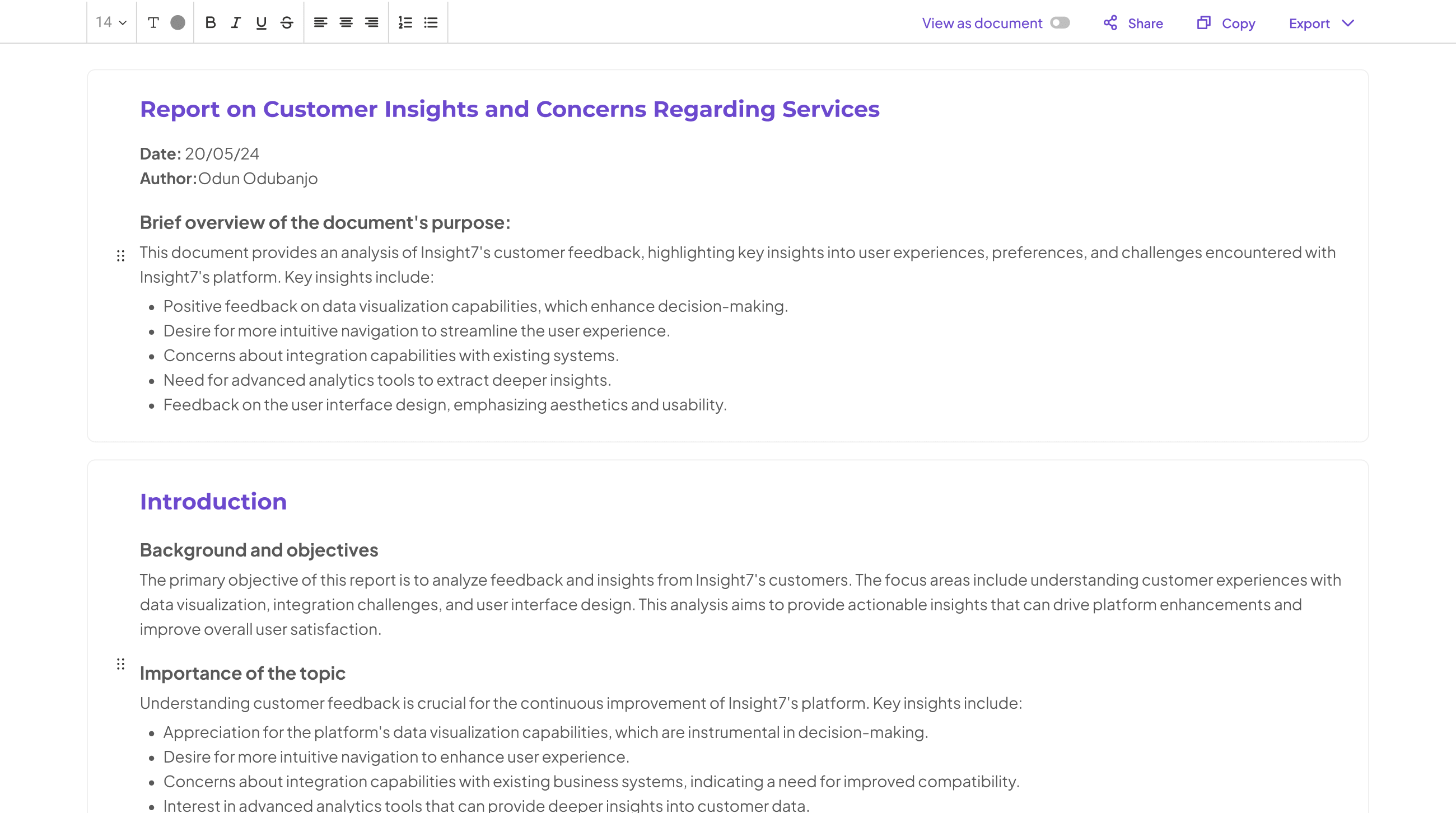Advertising Research Report: What to Include
-
Bella Williams
- 10 min read
Advertising analysis plays a crucial role in shaping effective marketing strategies. Understanding the essentials of advertising analysis empowers marketers to make informed decisions that resonate with target audiences. When evaluating advertising strategies, consider factors such as audience engagement, message clarity, and overall reach. Each component contributes to the effectiveness of an advertising campaign.
To thrive in today’s competitive market, businesses must harness data-driven insights from their advertising efforts. These insights help identify successful tactics and areas needing improvement. By focusing on advertising analysis essentials, marketers can ensure their campaigns not only attract attention but also drive meaningful interactions with their consumers.
Transcribe & extract insights from interviews. At Scale.

Key Components of an Advertising Research Report
An Advertising Research Report effectively communicates the essential insights gathered during the research process. To ensure clarity and comprehensiveness, several key components must be included. First, a thorough Executive Summary provides a condensed overview of findings and recommendations, allowing stakeholders to quickly grasp the report’s value.
Next, the Methodology section outlines the research design, sample selection, and data collection methods used. This transparency builds trust and helps readers understand how conclusions were drawn. Following this, a Results section presents the raw data and analysis, often visualized through charts and graphs to enhance understanding.
Finally, the Conclusion and Recommendations offer actionable insights based on the data analyzed. It’s essential to connect the findings back to the original research objectives, ensuring relevance and focus throughout the report. Each component works together to provide a complete view of the advertising analysis essentials.
Advertising Analysis Essentials: Data Collection Methods
In any comprehensive advertising analysis, data collection methods are crucial in supporting informed decisions. Each method serves a different purpose and provides unique insights that shape the overall findings. Traditional surveys, focus groups, and interviews can effectively gather qualitative data, drawing deeper insights into customer perceptions and preferences. On the other hand, quantitative methods, such as online questionnaires, can offer a broader view of market trends through statistical analysis.
Understanding these various methods—observational studies, experimental research, and secondary data analysis—enables researchers to select the most appropriate approach for their specific objectives. Observational studies involve watching consumer behavior in real-time, providing rich, context-driven insights. Experimental research establishes cause-and-effect relationships by controlling variables, allowing advertisers to assess the impact of specific strategies. Meanwhile, secondary data analysis utilizes existing data to uncover patterns, often enhancing the efficiency of research efforts. By mastering these data collection methods, professionals can ensure their advertising analysis is both relevant and actionable.
Advertising Analysis Essentials: Audience Segmentation
Understanding audience segmentation is vital for effective advertising analysis. It allows businesses to categorize their clientele based on shared characteristics. These characteristics may include demographics, behaviors, and purchasing patterns. By segmenting the audience, advertisers can tailor their messages to resonate with specific groups, enhancing engagement and conversions.
Key elements of audience segmentation include geographic, demographic, psychographic, and behavioral segmentation. Geographic segmentation divides the audience based on location, helping pinpoint local trends. Demographic segmentation focuses on variables such as age, gender, and income. Psychographic segmentation delves into values and lifestyles, creating a deeper connection with consumers. Lastly, behavioral segmentation looks at customer interactions and purchasing habits. This multi-faceted approach ensures advertisers reach the right people with the right message, making advertising analysis essentials critical for successful campaigns.
Generate Detailed Reports from Your Qualitative Data in Minutes.
Interpreting Results and Measuring Success
Interpreting results and measuring success is a vital part of any advertising analysis. This process involves evaluating both qualitative and quantitative data to determine the effectiveness of your marketing strategies. By tracking key metrics, such as website traffic and customer engagement rates, you gain deeper insights into your campaign performance. For instance, analyzing the close rate can provide significant evidence of how well your advertising resonates with customers.
To effectively measure success, consider the following key areas:
- Key Performance Indicators (KPIs): Identify and monitor specific KPIs, such as conversion rates and average revenue per customer, to gauge overall effectiveness.
- Qualitative Insights: Look beyond numbers; gather customer feedback to understand perceptions and experiences that may not be reflected in quantitative data.
- Benchmarking: Use historical data to set benchmarks for comparison, allowing you to track progress over time and make informed adjustments.
- Ongoing Evaluation: Regularly review these metrics to identify trends and areas for improvement, ensuring that your analysis remains relevant and actionable.
Through a comprehensive evaluation approach, you can ensure your advertising strategies are on the right track and steadily aligned with business objectives.
Advertising Analysis Essentials: Metrics and KPIs
Understanding essential metrics and key performance indicators (KPIs) is crucial for effective advertising analysis. Metrics such as website traffic, engagement rates, and conversion rates offer insights into campaign performance. Tracking these metrics over time allows advertisers to identify trends and adjust strategies accordingly.
Effective KPIs, like close rates and average ticket prices, provide a clearer picture of business success. Qualitative insights, such as customer feedback, add depth to this analysis by highlighting areas for improvement. By integrating both quantitative and qualitative data, advertisers can optimize their strategies and enhance their overall marketing effectiveness. Ultimately, mastering advertising analysis essentials empowers businesses to make informed decisions and drive successful campaigns.
Advertising Analysis Essentials: Reporting and Recommendations
Advertising Analysis Essentials involve a structured approach to reporting and making informed recommendations based on advertising data. Key insights should focus on customer needs, pain points, and actionable outcomes that stem from thorough analysis. Each report needs to tell a compelling story, showcasing not just the data but its implications for future advertising strategies.
A well-rounded report includes six essential components: objectives, data analysis, key findings, insights, recommendations, and metrics for success. First, clearly outline the objectives to set a roadmap for what you aim to achieve. Next, conduct a detailed data analysis to uncover trends and patterns. Key findings should summarize the important discoveries made during the analysis. Following this, extract insights for deeper understanding and suggest actionable recommendations to drive improvements. Finally, establish metrics to gauge the success of implemented strategies. By adhering to these guidelines, your report can effectively inform and guide future advertising efforts.
Conclusion: Synthesizing Advertising Analysis Essentials
In wrapping up this discussion on Advertising Analysis Essentials, it’s important to recognize how crucial insights drive effective marketing strategies. Successful analysis involves understanding customer feedback and identifying key themes that emerge during research. By synthesizing these insights, businesses can create tailored advertising campaigns that resonate with their target audience.
Transcribe & extract insights from interviews. At Scale.

Additionally, employing reliable data analysis tools can enhance understanding of market dynamics. The synthesis of these findings not only informs decision-making but also fosters an environment of continual growth. As brands navigate the complexities of advertising, embracing these essentials will empower them to refine strategies and connect meaningfully with consumers.







